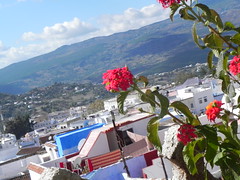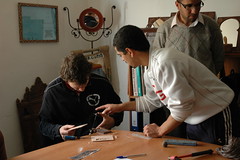 Our introduction to Morocco, while fascinating in itself, unfortunately felt very tailored to Western tastes. The ferry ride at sunset across the strait of Gibraltar was beautiful though–the shadow of Europe fading into an ever-darker distance, etc., but probably everyone in the group would agree it felt like we were only viewing a tourist-approved part of the country. However, since we arrived in Chefchaouen here in the mountains there has been a big change.
Our introduction to Morocco, while fascinating in itself, unfortunately felt very tailored to Western tastes. The ferry ride at sunset across the strait of Gibraltar was beautiful though–the shadow of Europe fading into an ever-darker distance, etc., but probably everyone in the group would agree it felt like we were only viewing a tourist-approved part of the country. However, since we arrived in Chefchaouen here in the mountains there has been a big change.
After a harrowing bus ride up and down and around the Rif mountains (During which we had to stop so the driver could descend into the depths of the bus and wrestle with some recurrently recalcitrant aspect of the drivetrain–we were told that some kids had stolen parts off the bus during the night…), we disembarked in the small city of Chefchaouen (“Look at the horns,” a Berber name referring to the surrounding mountains). Chefchaouen is blue. Predominantly, in color, I mean. Many of the buildings are painted blue for differing reasons depending on who you ask; the short answer is no one really knows why, and they continue to paint with this blue color because they always have. The city seems like it has physically grown out of the mountains–the buildings are odd, natural shapes, the streets are extremely narrow and have no pattern or logic other than to follow the shape of the mountain, there may be stairs at any point or a tunnel or a dead end… it’s not like any place I’ve ever been before. Added to the tranquil beauty of the surroundings, apart from a few disturbing exceptions, the people here are awesome. The prevailing attitude is refreshingly different; everyone is more relaxed, more friendly, more willing to talk about anything or nothing, than in many places I’ve been in the US. As I was leaving the shop of the Hat Man, promising to come back and buy a hat, the eponymous owner said in patient, sagacious tones, “You do, you don’t, it does not matter. This is your life–” (here he gestured at me) “–and this is mine (gesture at hats).”
Meeting the local students was a big surprise–in Spain we hardly met any Spaniards. It’s funny how impressed they are with us, just because we’re from the U.S., when in actuality we look like lazy slobs in comparison to these high school students who know three languages and study more in their spare time. It seems like their circumstances here impart a sense of urgency and drive to the youth towards education. Of course this may just be my skewed view based on the students who were selected for this exchange program, but still. I could write a lot more but it takes too long.
-Ben Nelson
 This has been one of the craziest and most unusual weeks of cross cultural so far, our crossing into Morocco. We finished our week in Sevilla, which was a good time, and then it was off to Morocco! I was excited and nervous to go, but we had all been looking forward to this. The travel was fun, and the ferry across from Gibraltar was the best. We got to spend most of the time out on the deck, even though the signs said not to, and played in the heavy wind and watched Africa get closer and closer. We landed in Ceuta, Spain’s city in Africa, and then crossed over to Morocco, where a beret wearing police officer got on the bus and checked our passports.
This has been one of the craziest and most unusual weeks of cross cultural so far, our crossing into Morocco. We finished our week in Sevilla, which was a good time, and then it was off to Morocco! I was excited and nervous to go, but we had all been looking forward to this. The travel was fun, and the ferry across from Gibraltar was the best. We got to spend most of the time out on the deck, even though the signs said not to, and played in the heavy wind and watched Africa get closer and closer. We landed in Ceuta, Spain’s city in Africa, and then crossed over to Morocco, where a beret wearing police officer got on the bus and checked our passports.
The next two nights we stayed in hotels in Tetouen and Tangier, and took tours of an old Medina marketplace and the coastlines, and saw some Moroccan entertainment. The morning we were leaving for Chefchaouen, where we would stay the week, we got on the bus and it wouldn’t shift. Apparently some boys had stolen some transmission cable, which must have some value here when resold. After another breakdown, we made it to Chefchaouen, a beautiful town in the mountains known for its houses with blue paint. We were all glad to finally get to the awesome house we stayed at all week, Dar Mesiana. Everyone was surprised to find that the week was mostly full of activities and that night we were going to meet some Moroccan students. They turned out to be around 15 or 16 years old, and they had been counting down the days to our arrival. This was somewhat awkward, because they had only just told us that we were even meeting them at all. The next day we went to their houses for lunch, and the food was good. We had a lot of activities this week, the most crazy being a hike to another village with a crazy SUV ride back. We also visited many non profit organizations. Some of us went to play basketball with the students, which turned out to be a full on match with their girls team, complete with jerseys.
Just everyday life here is so different from what we are used to. The way people dress is of course different, as well as the way they act, speak, do business, interact, and many other things. If you go near a shop, you never know what you might end up buying or whether the shopkeeper is a drug dealer or a medicine man from a Berber tribe in the desert. It is nice that everything is a little cheaper, which is helped by the exchange rate.
Probably one of the stranger shopkeepers is the hat man, who almost all of us have bought hats from. I sat with him as he modified some hats for me, and I learned many unusual things from him.
It is interesting to see the pros and cons of this society that is based heavily on the traditions of ancient tribes as well as the teachings of a religion that is relatively new to the land. This causes the people to seem hypocritical at times, which can be very frustrating. Hopefully our next weeks in Fez will be exciting learning experiences, and hopefully no one else gets sick.
-Jon Nagy